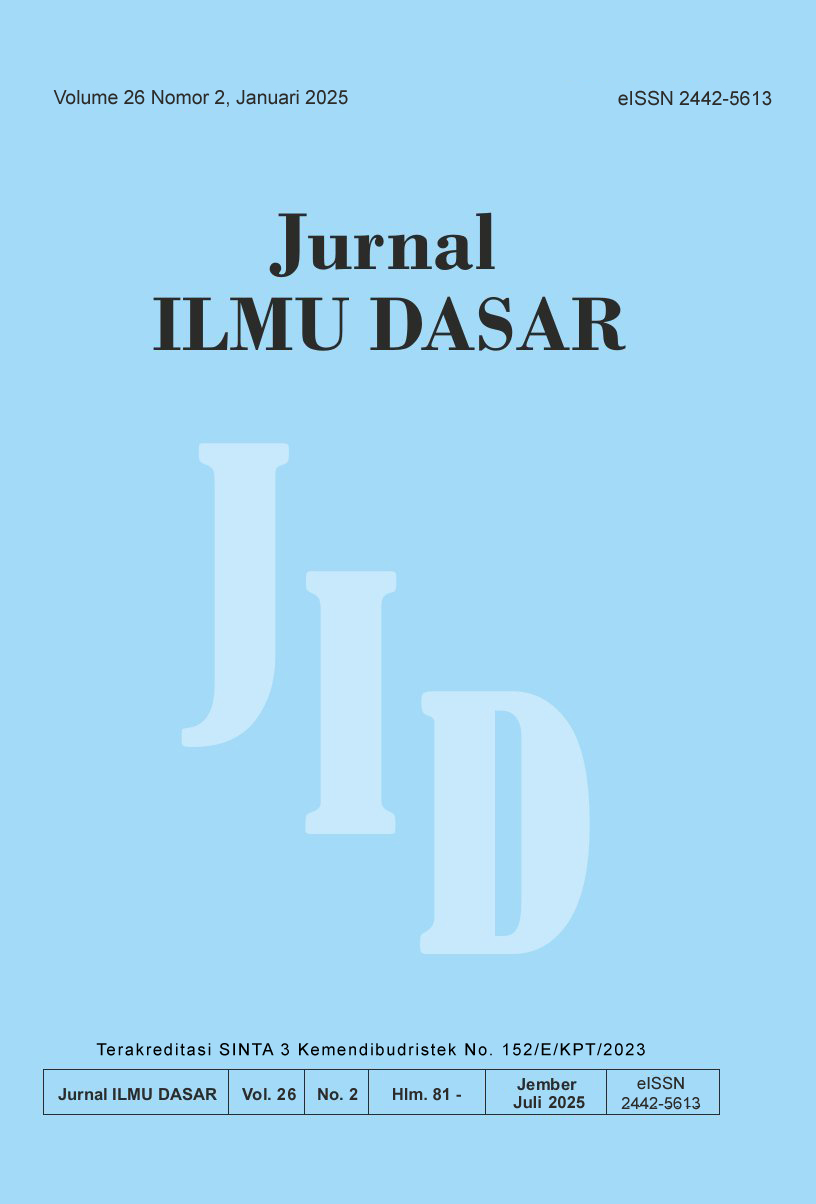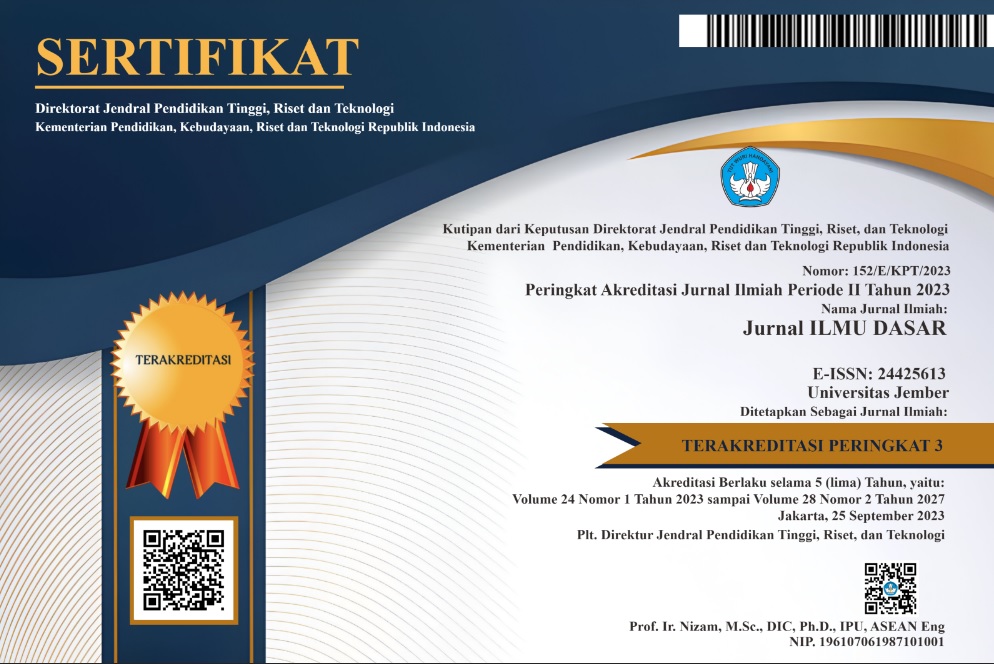Production and Characterization od Xylanase from Actinomyces ATG 70 Using CornCob Xylan Substrate
DOI:
https://doi.org/10.19184/jid.v26i2.53702Keywords:
Actinomycetes, Corn, Cob, Xylan, XylanaseAbstract
Xilan is a polysaccharide that can be used as a substrate for producing xylanase. Xylan can be obtained from processing xylan-rich agricultural waste such as corn cobs, which contain 12.4% xylan. Xilan can be hydrolyzed into xylose and xylooligosaccharide (XOS) using the enzyme Xilanase. Actinomycetes have dominant xylanolytic species, Actinomyces ATG 70 has semi-qualitative xylanolytic ability with an enzyme activity index of 3.21±0.55 in xylan media. This study was conducted by extracting xylan from corn cobs, rejuvenating Actinomyces ATG 70, preparing the inoculum, creating a standard curve, producing xylanase with pH optimization of the medium, testing xylanase activity, characterizing the pH and temperature of crude xylanase, and identifying the morphology and biochemical characteristics of Actinomyces ATG 70. Optimization of the pH of the xylanase production medium was achieved at pH 8, with xylanase activity of 10.07±0.13 U/mL. The crude xylanase was characterized for pH and temperature effects, and the optimal pH for crude xylanase was found to be pH 6 with xylanase activity of 7.64±0.66 U/mL, and the optimal temperature was 50°C with xylanase activity of 11.17±0.33 U/mL. The identification results showed that Actinomyces ATG 70 belongs to Gram-positive bacteria, with a positive catalase test, white colonies, cream-colored aerial mycelium, and cream-colored pigmentation. The spore structure consists of long chains of conidia, streptococcus-shaped cells, and can form aerial mycelium, thus the isolate belongs to the genus Streptomyces.
Downloads
References
Ameen, F. (2023). Purification and Characterization of Xylanase Produced by Aspergillus fumigatus Isolated from the Northern Border Region of Saudi Arabia. Fermentation, 9(7), 1-14. https://doi.org/10.3390/fermentation9070595
Armiliandi, R., & Irdawati. (2024). Pengaruh inkubasi suhu dalam memproduksi enzim xilanase dari konsosrsium trikultur bakteri termofilik. Jurnal Pendidikan Tambusai, 8(1), 188-194.
Avci, U. (2022). Trafficking of Xylan to Plant Cell Walls. Biomass, 2(3), 188-194. https://doi.org/10.3390/biomass2030012
Begum, K., Mannan, S. J., Rezwan, R., Rahman, M. M., Rahman, M. S., & Kamal, A. N. E. (2017). Isolation and Characterization of Bacteria with Biochemical and Pharmacological Importance from Soil Samples of Dhaka City. Dhaka University Journal of Pharmaceutical Sciences, 16(1), 129-136. https://doi.org/10.3329/dujps.v16i1.33390
Chen, Z., Zaky, A. A., Liu, Y., Chen, Y., Liu, L., Li, S., & Jia, Y. (2019). Purification and characterization of a new xylanase with excellent stability from Aspergillus flavus and its application in hydrolyzing pretreated corncobs. Protein Expr Purif, 154, 91-97. https://doi.org/10.1016/j.pep.2018.10.006
De Simeis, D., & Serra, S. (2021). Actinomycetes: A Never-Ending Source of Bioactive Compounds-An Overview on Antibiotics Production. Antibiotics (Basel), 10(5), 1-32. https://doi.org/10.3390/antibiotics10050483
Gupta, G. K., Dixit, M., Kapoor, R. K., & Shukla, P. (2022). Xylanolitic enzymes in pulp and paper industry: new technologies and perspective. Molecular Biotechnology, 64(1), 130-143.
He, J., Su, L., Sun, X., Fu, J., Chen, J., & Wu, J. (2014). A novel xylanase from Streptomyces sp. FA1: Purification, characterization, identification, and heterologous expression. Biotechnology and Bioprocess Engineering, 19(1), 8-17. https://doi.org/10.1007/s12257-013-0490-2
Holt, J. G., Krieg, N. R., Sneath, P. H. A., Staley, J. T., & Williams, S. T. (1994). Bergey’s Manual of Determinative Bacteriology. Ninth Edition. . Lippincott Williams & Wilkins.
Huang, C., Yu, Y., Li, Z., Yan, B., Pei, W., & Wu, H. (2022). The preparation technology and application of xylo-oligosaccharide as prebiotics in different fields: A review. Frontiers in Nutrition, 9(1), 996811. https://doi.org/10.3389/fnut.2022.996811
Huda, C., Salni, & Melki. (2012). Penapisan aktivitas antibakteri dari bakteri yang berasosiasi dengan karang lunak Sarcophyton sp. Maspari Journal, 4(1), 69-76.
Irdawati, I., Sofiyyana, A., Advinda, L., Fiffendy, M., Salvia, S., Syamsuardi, S., Agustien, A., Rilda, Y., & Yahya, Y. (2021). Optimization of agricultural waste substrate as an alternative medium for xylan in producing xylanase enzymes by thermophilic bacteria. Journal of Physics: Conference Series, 1940(1), 1-7.
Karthik, Y., Kalyani, M. I., Sheetal, K. S., Rakshitha, D., & Bineesha, K. B. (2020). Cytotoxic and antimicrobial activities of microbial proteins from mangrove soil actinomycetes of Mangalore, Dakshina Kannada. Biomedicine, 40(1), 59-67. https://doi.org/10.51248/.v40i1.104
147
Kim, J. H., & Chi, W. J. (2024). Molecular and Biochemical Characterization of Xylanase Produced by Streptomyces viridodiastaticus MS9, a Newly Isolated Soil Bacterium. Journal of Microbiology and Biotechnology, 34(1), 176-184. https://doi.org/10.4014/jmb.2309.09029
Li, Q., Chen, X., Jiang, Y., & Jiang, C. (2016). Cultural, physiological, and biochemical identification of actinobacteria in Actinobacteria—Basics and Biotechnological Applications, D. Dhanasekaram and Y. Jiang, Eds. IntechOpen.
Liang, M., Lin, Y., Sun, L., Pang, H., Wei, H., Huang, R., Wei, Y., & Du, L. (2023). Discovery of a Novel β-xylosidase with Xylanase Activity and Its Application in the Production of Xylitol from Corncob Xylan. Fermentation, 9(7). https://doi.org/10.3390/fermentation9070606
Madigan, M. T., Bender, K. S., Buckley, D. H., Sattley, W. M., Stahl, D. A., & Brock, D. (2018). Brock Biology of Microorganisms 15th Edition. Pearson Education.
Miller, G. L. (1959). Use of dinitrosalycylic acid reagent for determination of reducing sugar. Analitycal Chemistry, 31(3), 426-428.
Ngamcharungchit, C., Chaimusik, N., Panbangred, W., Euanorasetr, J., & Intra, B. (2023). Bioactive Metabolites from Terrestrial and
Marine Actinomycetes. Molecules, 28(15), 1-33. https://doi.org/10.3390/molecules28155915
Prasetya, D., & Abadi, M. F. (2022). Isolasi dan identifikasi Streptomyces sp. pada kolam tanah di Desa Tenggur Tulungagung Jawa Timur. The Journal of Medical Laboratory, 10(1), 1802.
Purba, N., Gunam, I. B. W., & Wijaya, I. M. M. (2020). Produksi enzim selulase kasar dari isolat bakteri BS28 menggunakan substrat brangkasan jagung dengan perlakuan konsentrasi inokulum dan komposisi media yang berbeda. Jurnal Rekayasa dan Manajemen Agroindustri, 10(1), 1802.
Richana, N., Irawadi, T. T., Nur, M. A., Sailah, I., Syamsu, K., & Arkenan, Y. (2007). Ekstraksi xilan dari tongkol jagung. Jurnal Pascapanen, 4(1), 38-43.
Ruanpanun, P., Tangchitsomkid, N., Hyde, K. D., & Lumyong, S. (2010). Actinomycetes and fungi isolated from plant-parasitic nematode infested soils: screening of the effective biocontrol potential, indole-3-acetic acid and siderophore production. World Journal of Microbiology and Biotechnology, 26(9), 1569-1578. https://doi.org/10.1007/s11274-010-0332-8
Salupi, W., Yopi, Y., & Meryandini, A. (2015). Xylanase Activity of Streptomyces violascences BF 3.10 on Xylan Corncobs and its Xylooligosaccharide Production. Media Peternakan, 38(1), 27-33. https://doi.org/10.5398/medpet.2015.38.1.27
Sapkota, A., Thapa, A., Budhathoki, A., Sainju, M., Shrestha, P., & Aryal, S. (2020). Isolation, Characterization, and Screening of Antimicrobial-Producing Actinomycetes from Soil Samples. International Journal of Microbiology, 2020(1), 2716584. https://doi.org/10.1155/2020/2716584
Selim, M. S. M., Abdelhamid, S. A., & Mohamed, S. S. (2021). Secondary metabolites and biodiversity of actinomycetes. Journal of Genetic Engineering and Biotechnology, 19(1), 72. https://doi.org/10.1186/s43141-021-00156-9
Swelam, M. S., El awady, M. E., El-khonezy, M., Hassan, M. G., Selim, M. S., & Salam, S. S. A. (2024). Screening and optimization of the production of xylanase enzyme from Streptomyces. Journal of Basic and Environmental Sciences, 11(1), 51-59.
Torabi, A., Shahidi Bonjar, G. H., Abdolshahi, R., Pournamdari, M., Saadoun, I., & Barka, E. A. (2019). Biological control of Paecilomyces formosus, the causal agent of dieback and canker diseases of pistachio by two strains of Streptomyces misionensis. Biological Control, 137(1), 1-13. https://doi.org/10.1016/j.biocontrol.2019.104029
Utarti, E., Alim, S. F., & Setyati, D., Sutoyo, S. (2021). Isolasi Aktinomiset Pelarut Fosfat Asal Perakaran Tembakau (Nicotiana tabacum L.) di Antirogo Jember. Metamorfosa: Journal of Biological Sciences, 8(2), 260-267. https://doi.org/10.24843/metamorfosa.2021.v08.i02.p09
Utarti, E., Suwanto, A., Suhartono, M. T., & Meryandini, A. (2021). Lytic polysaccharide monooxygenase of soil actinomycete with potential use for lignocellulose biodegradation. Malaysian Journal of Microbiology, 17(1), 60-68. https://doi.org/10.21161/mjm.200869
Wang, J., Liang, J., Li, Y., Tian, L., & Wei, Y. (2021). Characterization of efficient xylanases from industrial-scale pulp and paper wastewater treatment microbiota. AMB Express, 11(1), 1-11. https://doi.org/10.1186/s13568-020-01178-1
Downloads
Published
Issue
Section
License
Copyright (c) 2025 Taya Preira Farennina, Amelia Fahreza Putri, Sattya Arimurti, Rudju Winarsa, Esti Utarti

This work is licensed under a Creative Commons Attribution-ShareAlike 4.0 International License.








